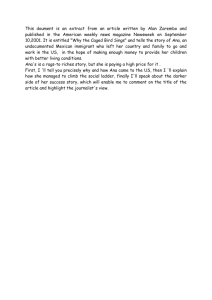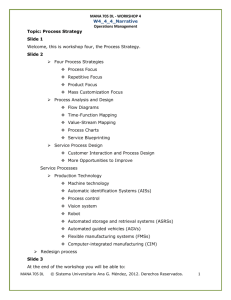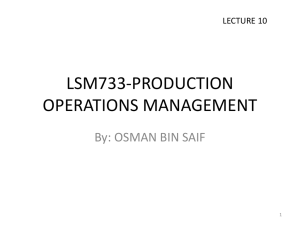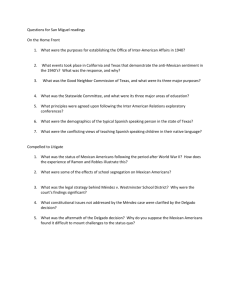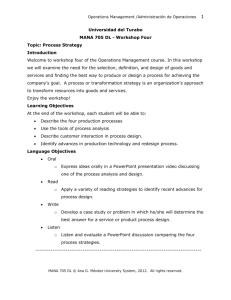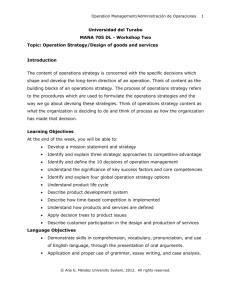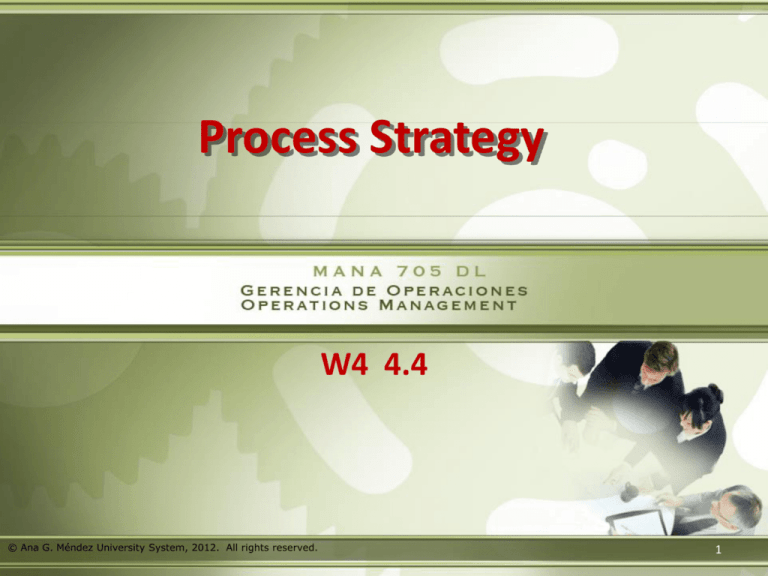
Process Strategy
W4 4.4
© Ana G. Méndez University System, 2012. All rights reserved.
© Sistema Universitario Ana G. Méndez, 2011. Derechos Reservados.
1
Four Process Strategies
Process Focus
Repetitive Focus
Product Focus
Mass Customization Focus
Process Analysis and Design
Flow Diagrams
Time-Function Mapping
Value-Stream Mapping
Process Charts
Service Blueprinting
Service Process Design
Customer Interaction and Process Design
More Opportunities to Improve
Service Processes
Production Technology
Machine technology
Automatic identification Systems
(AISs)
Process control
Vision system
Robot
Automated storage and retrieval
systems (ASRSs)
Automated guided vehicles (AGVs)
Flexible manufacturing systems
(FMSs)
Computer-integrated
manufacturing (CIM)
Redesign process
2
At the end of the workshop, you will be able to:
1. Describe the four production processes
2. Use the tools of process analysis
3. Describe customer interaction in process design.
4. Identify advances in production technology and
redesign process.
3
High Variety,
one or few
products
Process Focus
projects, job shops
(machine, print,
carpentry)
Variety
Changes in runs
Mass Customization
(difficult to achieve, but
huge rewards)
Repetitive Focus
Product Focus
(commercial baked
goods, steel, glass)
Low Variety,
long runs
only
Low
Volume
Volume
High
Volume
Changes in attributes
4
Four basic strategies
Process focus
Repetitive focus
Product focus
Mass customization
5
Job Shop or Intermittent Process
Many
departments and
many routings
Grinding
Forging
Lathes
Painting
Welding
Drills
Office
Milling
machines
Foundry
6
This is a process flow diagram
for a high quality product and
service in the industry.
Shows the flow of
material or service
7
Assembly Line
Modules
combined
for many
output
options
Raw
materials
and
module
inputs
Few
modules
8
Continuous Work Flow
Few
inputs
Station 1
Station 2
Station 3
Station 4
Output
variations
in size,
shape, and
packaging
9
Repetitive Focus
Flexible people
and equipment
Supportive
supply chains
Effective
scheduling
techniques
Modular techniques
Mass Customization
Rapid
throughput
techniques
Process-Focused
Product-Focused
High variety, low volume
Low utilization (5% to 25%)
General-purpose equipment
Low variety, high volume
High utilization (70% to 90%)
Specialized equipment
10
Flow Diagrams - Show
the movement of
materials
Time-Function Mapping
- Shows flow and time
frame
Value-Stream Mapping Shows flow, time. and
value added beyond the
immediate organization
Process Charts - Use
symbols to show key
activities
Service Blueprinting focuses on
customer/provider
interaction
11
12
Time-Function Mapping
Order
product
Receive
product
Process
order
Wait
Print
Wait
Wait
Wait
Extrude
Move
12 days
13 days
1 day
4 days
1 day 10 days
52 days
Move
1 day
0 day
1 day
13
Value Stream Mapping
14
Process Charts Symbols
15
16
Degree of Customization
High
Low
Mass Service
Degree of Labor
High
Private
banking
Commercial
banking
Full-service
stockbroker
Retailing
Limited-service
stockbroker
Warehouse and
catalog stores
No-frills
airlines
Generalpurpose law firms
Boutiques
Service Factory
Low
Professional Service
Fast-food
restaurants
Airlines
Law clinics
Service Shop
Specialized
hospitals
Fine-dining
restaurants
Hospitals
17
Machine technology
Automatic identification Systems (AISs)
Process control
Vision system
Robot
Automated storage and retrieval systems
(ASRSs)
Automated guided vehicles (AGVs)
Flexible manufacturing systems (FMSs)
Computer-integrated manufacturing (CIM)
18
Increased precision
Increased productivity
Increased flexibility
Improved environmental impact
Reduced changeover time
Decreased size
Reduced power requirements
Improved data acquisition
Reduced data entry errors
Increased speed
Increased scope of process
automation
Bar Codes
RFID
Prepared by María Vázquez
19
Increased process stability
Increased process precision
Real-time provision of
information for process
evaluation
Data available in many forms
Particular aid to inspection
Consistently accurate
Never bored
Modest cost
Superior to individuals
performing the same tasks
Prepared by María Vázquez
20
Perform monotonous or
dangerous tasks
Automated placement and
withdrawal of parts and products
Perform tasks requiring
significant strength or
endurance
Reduced errors and labor
Particularly useful in inventory and
test areas of manufacturing firms
Generally enhanced
consistency and accuracy
Prepared by María Vázquez
21
Computer controls both the workstation and
the material handling equipment
Enhance flexibility and reduced waste
Can economically produce low volume at
high quality
Reduced changeover time and increased
utilization
Stringent communication requirement
between components
Electronically guided and
controlled carts
Used for movement of products
and/or individuals
22
Extension of flexible manufacturing
systems
Backwards to engineering and
inventory control
Forward into warehousing and
shipping
Can also include financial and
customer service areas
Reducing the distinction between lowvolume/high-variety, and highvolume/low-variety production
© Sistema Universitario Ana G. Méndez, 2011. Derechos Reservados.
23
The fundamental rethinking of
business processes to bring
about dramatic improvements in
performance
Relies on reevaluating the
purpose of the process and
questioning both the purpose
and the underlying assumptions
Requires reexamination of the
basic process and its objectives
Focuses on activities that cross
functional lines
Any process is a candidate for
redesign
24
End
After studying the content, please complete
the assigned activities.
© Ana G. Méndez University System, 2012. All rights reserved.
25


